Plant protein benefits can include a reduced environmental impact compared to animal proteins, health benefits tied to nutrients found in plants (e.g. fiber, zinc, vitamin C), as well as alignment to ethical or food safety concerns some individuals have with animal foods.
With the growing demand for protein, interest in plant proteins is also rising. Multiple factors are contributing to this growth, such as food safety concerns, ethics, environmental concerns, rise in food intolerances, allergies and “free-from” foods, sustainability, increased accessibility of vegetarian and vegan foods and the adoption of proactive approaches to health and wellbeing by consumers. These factors can resonate with all types of consumers, meaning that the increasing number of vegetarian and vegans is not the only place that demand for plant protein is coming from.
It’s also not necessarily about totally replacing meat in the diet, but more about consumers wanting a greater variety of protein beyond animal sources (meat, eggs and dairy) to include more plant sources, an approach often referred to as “flexitarian”. The quest for dairy-free and soy-free products is also driving the rise in alternative sources of protein such as pea, pulse, nut and seed, quinoa, rice, hemp, potato, and oat proteins, among others.
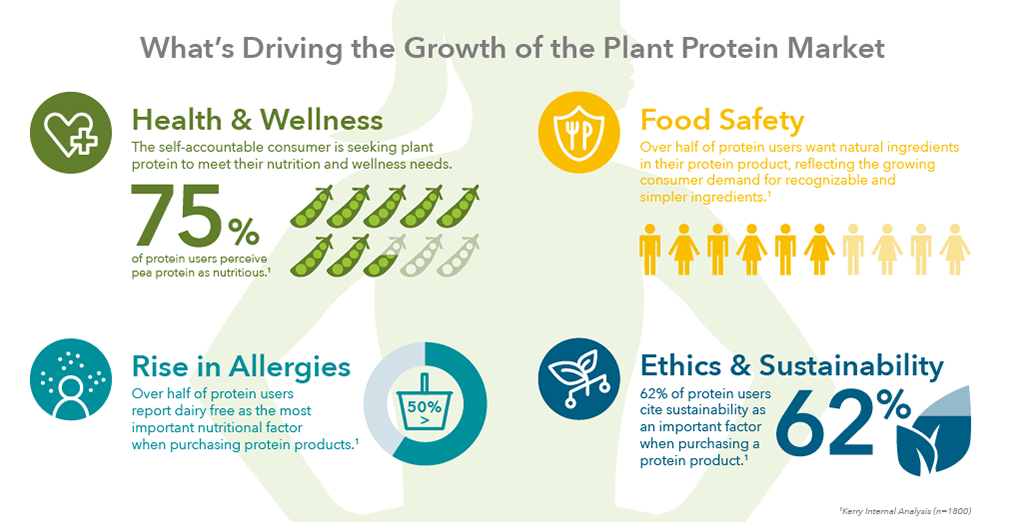
How does plant protein differ from animal protein?
Amino acids
To answer this question, it is important to think about the building blocks that make up proteins: amino acids. In total, there are 20 types of amino acids that the human body uses to build proteins. Most people think of proteins we eat being used to make our muscles, but amino acids are important for every cell in our body. Amino acids are classified as either essential or non-essential. Our bodies cannot make essential amino acids, meaning they are “essential” for us to consume in our diet. Non-essential amino acids, on the other hand, can be created by our bodies, so they are not essential for us to get from our diet.
Protein quality
For optimal health, our bodies need all of the essential amino acids in the right ratios, similar to the way that a house needs all of the right raw materials in the right proportions when it’s being built. Animal protein sources, such as meat, fish, poultry, eggs, and dairy, are considered “complete” sources of protein because they typically contain all of the essential amino acids in the right proportions to meet the body’s needs. On the other hand, plant-based proteins, such as cereals, legumes, and nuts, are lower in certain essential amino acids. They are generally low in methionine (e.g. beans, nuts and seeds), lysine (e.g. grains like wheat), or tryptophan (e.g. corn), and higher in non-essential amino acids arginine, glycine, alanine and serine.
Plant proteins are also usually harder to digest than animal proteins. The fibers and other components in plants make it harder for digestive enzymes to break down proteins for absorption in our digestive tract. The good news is that this same trait of plants can be beneficial when it comes to things like heart health or blood sugar management, due to limiting the absorption of carbohydrates or cholesterol. Processing via soaking, cooking, concentration, or isolation can also make plant proteins easier to digest.
“Protein quality” is a measurement of the amino acid composition of a protein (e.g. how well it meets our body’s amino acid needs), as well as digestibility. Different measurements of protein quality are used around the world, including the PDCAAS (Protein Digestibility-Corrected Amino Acid Score), DIAAS (Digestible Indispensable Amino Acid Score), and the PER (Protein Efficiency Ratio). This report from the Food and Agriculture Organization of the United Nations provides in-depth descriptions of each method, if you’re looking for more information.
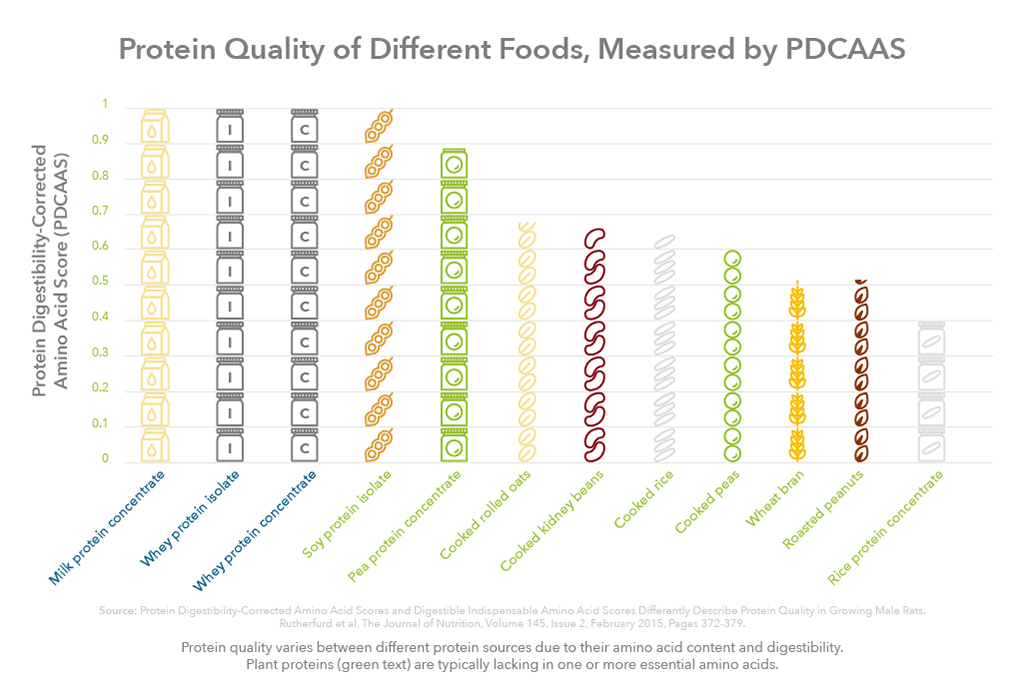
|
Get KHNI articles delivered to your inbox
|
What are the best sources of plant protein? Is plant protein enough?
There are some plant proteins, such as soy (read our blog ‘Science Supports Soy for a Healthy Diet) and potato, that are considered to be complete proteins since they contain all of the essential amino acids in the right proportions. When we look at the whole diet rather than a specific food, though, the terms “complete” and “incomplete” protein may be misleading. The Academy of Nutrition and Dietetics (2016) states that protein from a variety of plant foods, eaten during the course of a day, can supply enough of all essential (indispensable) amino acids when calorie requirements are met. After all, our bodies are constantly remodeling our cells and tissues, so as long as enough of the body’s building blocks (amino acids) are provided throughout the day in the right amounts, our bodies receive a “complete” protein source over time. This is why it’s important for different sources of plant proteins to be used in combination to complement their deficient amino acids. For example, combining cereal (low in lysine but contains methionine) and legume (low in methionine but contains lysine) protein sources will ensure our bodies get enough lysine and methionine. This same technique can be used to create foods with a higher protein quality when formulating during product development.
The importance of protein quality for certain populations, like athletes or aging populations, is an area of growing research.
Protein quality is not always the bottom line, though. Many plant sources of protein come with a host of other nutrients, like complex carbohydrates, fibers, vitamins, and minerals. Many of these components are removed from protein concentrates or isolates, so even though the protein quality score will be higher for a pea protein isolate compared to cooked peas, it will be missing some of these other nutrients important for health. The ability of plant sources of protein to contribute more to a diet than protein has led to their inclusions in many dietary recommendations around the world.
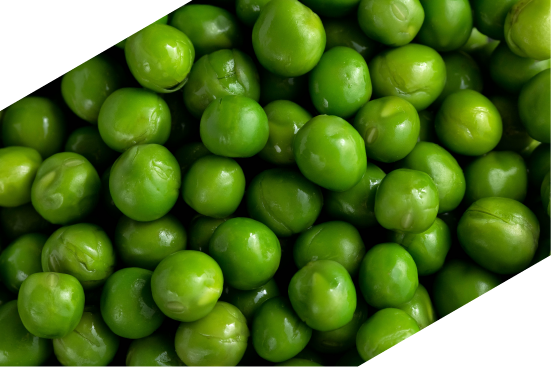
Plant-based dietary recommendations
Many nonprofit and government institutions, such as the American Institute for Cancer Research, 2015-2020 Dietary Guidelines for Americans (DGA), and Health Canada encourage plant-based diets. Although only 3.3% of adult Americans are vegetarian or vegans, this increases to 6% in younger adults (18-34 y) (AND, 2016). According to the Mintel 2017 Food and Trend “Power of the Plants” report, US consumers perceive plant-based food and beverage products as more natural (68% vs. 41%) and healthy (68% vs. 39%) compared to all US food and drink products. This has led to ‘plant-based’ spreading to wider groups of consumers, not just vegetarians and vegans.
A well-planned plant-based diet that includes vegetables, fruits, whole grains, legumes, nuts and seeds can provide balanced nutrition to meet individual needs and prevent nutrient deficiencies. A recent report from the USDA Economic Research Services found that 70% of U.S. calories consumed in 2010 were from plant-based foods (Figure 1). According to the DGA, protein needs at all ages, including those for athletes (read our blog: Three Things You Need to Know About Protein for Exercise Performance), can be achieved with a balanced vegetarian diet. Some evidence suggests that protein is used less efficiently with aging, so it is important that older individuals consuming plant-based diets include protein-rich foods such as legumes and soy foods in their diets.
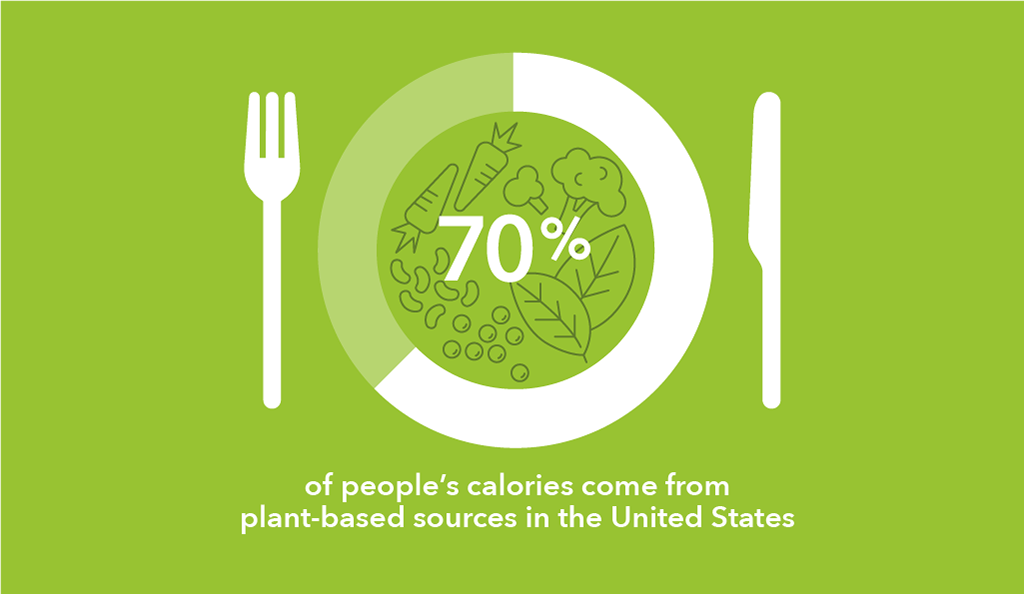
Source: ERS/USDA Loss-adjusted availability of U.S. calories by food group
Is plant protein better than animal protein? Plant protein benefits for health
The answer to this question is not black and white because proteins are rarely found in isolation; a wide variety of other nutrients come along as co-passengers with protein in plants. These nutrients include fiber, vitamins (e.g. Folate, vitamin C, vitamin A), and minerals (e.g. Iron, Zinc, Calcium). As a result, diets high in plant protein, such as the vegetarian diet pattern, are associated with health benefits.
A scientific review published in 2019 titled ‘Role of plant protein in nutrition, wellness, and health’ (Ahren 2019) explored these benefits. The authors found that plant proteins in the diet can be protective for metabolic health, with links found between plant protein intake and healthier markers of heart health and blood sugar management. For example, one study found substituting legumes for red meat can significantly improve fasting blood glucose, insulin, triglyceride, and LDL-cholesterol concentrations in people with type 2 diabetes (Ahren 2019).
However, according to the authors,
Much of the research explores the health benefits of plant protein as a whole food, rather than an isolate, making it difficult to expressly demonstrate that any potential benefit is actually derived from plant proteins, rather than from the vitamins, minerals, or phytochemicals associated with a plant-based diet. (Ahren 2019)
Studies suggest that vegetarians tend to have lower body weight, cholesterol and blood pressure levels. As a result, people who consume plant-based diets have been shown to be at lower risk for stroke and heart disease. The host of nutrients and phytonutrients found in plants are also associated with a reduced risk of certain cancers (AND 2016).
Bone and muscle health also stand to benefit. Plant-based diets rich in nutrients like protein, magnesium, potassium, and vitamins K and C can improve bone health, however a plant-based diet low in these nutrients can have the opposite effect. Emerging evidence suggests that plant proteins can also play a role in muscle protein synthesis, especially when combining different plant proteins to provide the body with a balanced amino acid profile.
However, it is important to remember is that a plant-based diet is one of many tools in the toolbox for improving health. There are also many studies that show no benefit when substituting plant-based proteins for animal proteins. A diet that is rich in nutrients and in a healthy calorie range, whether it is animal-based or plant-based, will most likely lead to good health.
Sustainability benefits of plant protein
Plant-based diets are more environmentally sustainable than animal-based diets due to the use of fewer natural resources and less environmental damage caused by their production. Livestock are typically fed with plants rich in protein, so if we consume the plant protein directly instead, we are able to avoid the resource inputs required to raise the livestock. For example, to produce 1 kg protein from kidney beans requires 18 times less land, 10 times less water, 9 times less fuel, 12 times less fertilizer and 10 times less pesticide compared to producing 1 kg protein from beef (AND, 2016). By eating less meat and dairy, the diet-related environment impact can be cut by nearly one-half while also reducing agriculture’s pressure on the environment (WRI).
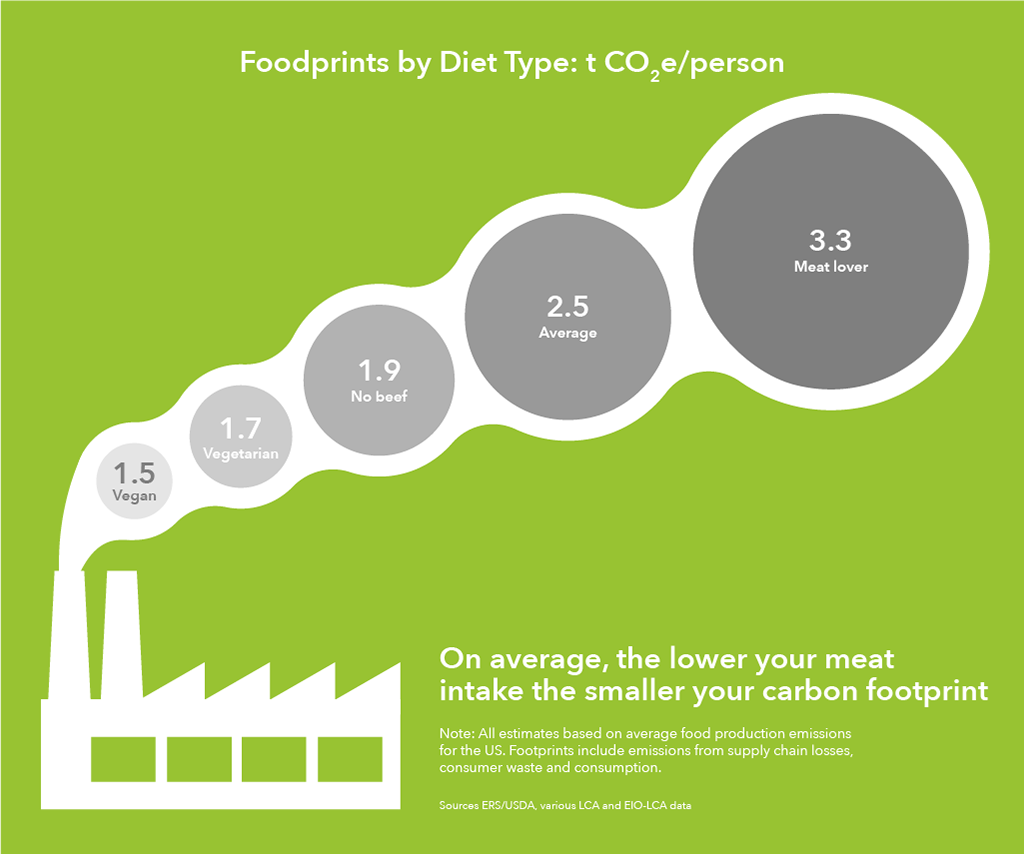
What’s the Future for Plant Proteins in Packaged Goods?
 Translating the benefits of plant proteins packaged goods that are convenient for consumers can be difficult. Although consumers are becoming more aware of their health and are trying to make better food choices, taste and texture are also important. In Kerry’s market research report Winning with Plant-Based, results showed that although nutrition and health were key purchase drivers, taste and acceptable ingredients were two of the most important attributes of a product once purchased (Kerry Primary Research, USA, 2020).
Translating the benefits of plant proteins packaged goods that are convenient for consumers can be difficult. Although consumers are becoming more aware of their health and are trying to make better food choices, taste and texture are also important. In Kerry’s market research report Winning with Plant-Based, results showed that although nutrition and health were key purchase drivers, taste and acceptable ingredients were two of the most important attributes of a product once purchased (Kerry Primary Research, USA, 2020).
In order to successfully meet the needs of consumers, food and beverage manufacturers need to take this into account along with the need to complement amino acid profiles of different plant proteins to create a complete protein source when creating protein products. By utilizing processing technologies to improve texture, as well as choosing applications that complement the flavor of plant proteins, it is possible to deliver the benefits of plant protein in a way that delivers on the taste expectations of consumers. Specific opportunities include snacking, non-dairy drinks, pre-prepared vegetables and meat alternatives.
Contributors:
-
References
- Academy of Nutrition and Dietetics. Position of the Academy of Nutrition and Dietetics: Vegetarian Diets. J Acad Nutr Diet. 2016; 116:1970-1980.
- Ahren AT, Jonnalagadda SS, Slavin JL. Role of plant protein in nutrition, wellness, and health. Nutrition Reviews. 2019. 0(0):1-13.
- Appel LJ, Sacks FM, Carey VJ, et al ; OmniHeart Collaborative Research Group. Effects of protein, monounsaturated fat, and carbohydrate intake on blood pressure and serum lipids: results of the OmniHeart randomized trial. JAMA. 2005; 16;294:2455-2464.
- Babault N, Paizis C, Deley G, et al. Pea proteins oral supplementation promotes muscle thickness gains during resistance training: a double-blind, randomized, Placebo-controlled clinical trial vs. Whey protein. J Int Soc Sports Nutr. 2015; 12:3 Published online 2015 Jan 21. doi: 10.1186/s12970-014-0064-5.
- Burke LM, Winter JA, Cameron-Smith D, et al. Effect of intake of different dietary protein sources on plasma amino acid profiles at rest and after exercise. Int J Sport Nutr Exerc Metab. 2012;22:452–62.
- Cragi WJ. Nutrition concerns and health effects of vegetarian diets. Nutr Clin Pract. 2010;25:613-620. doi: 10.1177/0884533610385707.
- Curran J. The nutritional value and health benefits of pulses in relation to obesity, diabetes, heart disease and cancer. Br J Nutr. 2012;108 Suppl 1:S1-2. doi: 10.1017/S0007114512003534.
- Dahl WJ, Foster LM, Tyler RT. Review of the health benefits of peas (Pisum sativum L.). Br J Nutr. 2012;108 Suppl 1:S3-10. doi: 10.1017/S0007114512000852.
- Jenkins DJ, Wong JM, Kendall CW, et al. The effect of a plant-based low-carbohydrate (“Eco-Atkins”) diet on body weight and blood lipid concentrations in hyperlipidemic subjects. Arch Intern Med. 2009;169:1046-1054. doi:10.1001/archinternmed.2009.115.
- Marventano S, Izquierdo Pulido M, Sánchez-González C, et al. Legume consumption and CVD risk: a systematic review and meta-analysis. Public Health Nutr. 2017;20:245-254. doi: 10.1017/S1368980016002299.
- Minetl. The new products people want to buy … and why: Plant-based products. January 2017. www.Mintel.com
- Mudryj AN, Yu N, Aukema HM. Nutritional and health benefits of pulses. Appl Physiol Nutr Metab. 2014;39:1197-1204. doi: 10.1139/apnm-2013-0557.
- Rebello CJ, Greenway FL, Finley JW. A review of the nutritional value of legumes and their effects on obesity and its related co-morbidities. Obes Rev. 2014;15:392-407. doi: 10.1111/obr.12144.
- Rebello CJ, Greenway FL, Finley JW. Whole grains and pulses: a comparison of the nutritional and health benefits. J Agric Food Chem. 2014;62:7029-7049. doi: 10.1021/jf500932z.
- Reidy PT, Walker DK, Dickinson JM, et al. Protein blend ingestion following resistance exercise promotes human muscle protein synthesis. J Nutr. 2013;143:410–6. doi: 10.3945/jn.112.168021.
- Richter CK, Skulas-Ray AC, Champagne CM, Kris-Etherton PM. Plant protein and animal proteins: do they differentially affect cardiovascular disease risk? Adv Nutr. 2015;6:712-728. doi: 10.3945/an.115.009654.
- Scientific Report of the 2015 Dietary Guidelines Advisory Committee. Appendix E-2.37: Dietary Patterns and Sustainability Evidence Portfolio. https://health.gov/dietaryguidelines/2015-scientific-report/PDFs/Appendix-E-2.37.pdf
- U.S. Department of Health and Human Services and U.S. Department of Agriculture. 2015 – 2020 Dietary Guidelines for Americans. 8th Edition. December 2015. Available at https://health.gov/dietaryguidelines/2015/guidelines/
- USDA Economic Research Services. Seventy percent of U.S. calories consumed in 2010 were from plant-based foods. https://www.ers.usda.gov/data-products/chart-gallery/gallery/chart-detail/?chartId=81864; https://www.ers.usda.gov/amber-waves/2016/december/a-look-at-calorie-sources-in-the-american-diet/
- van Vliet S, Burd NA, van Loon LJC. The skeletal muscle anabolic response to plant-versus animal-based protein consumption. J Nutr. 2015;145:1981-1991.
- World Resource Institute. Shifting diets for a sustainable future. http://www.wri.org/publication/shifting-diets

 Satya Jonnalagadda Ph.D., MBA, RD has a strong Human Nutrition and Foods background in research, education, and clinical care, with areas of expertise including, chronic diseases treatment and management, specifically Cardiovascular Disease, Diabetes, and Obesity; Sports Nutrition, and Critical Care Nutrition.
Satya Jonnalagadda Ph.D., MBA, RD has a strong Human Nutrition and Foods background in research, education, and clinical care, with areas of expertise including, chronic diseases treatment and management, specifically Cardiovascular Disease, Diabetes, and Obesity; Sports Nutrition, and Critical Care Nutrition.  Nathan Pratt, PhD, RD is a nutrition scientist passionate about finding ways to make science easily used and understood to improve health. During his time working with the food and beverage industry he has worked with companies globally to bridge the gap between consumer insights and nutrition science and to better leverage nutrition in their strategies and product development.
Nathan Pratt, PhD, RD is a nutrition scientist passionate about finding ways to make science easily used and understood to improve health. During his time working with the food and beverage industry he has worked with companies globally to bridge the gap between consumer insights and nutrition science and to better leverage nutrition in their strategies and product development.  Orlaigh graduated with a BSc in Human Nutrition and Dietetics from Dublin Institute of Technology and Trinity College Dublin. After working as a clinical dietitian specialising in maternal nutrition, senior nutrition and critical care in a Dublin teaching hospital for several years, Orlaigh brought her nutrition expertise to the food and beverage industry.
Orlaigh graduated with a BSc in Human Nutrition and Dietetics from Dublin Institute of Technology and Trinity College Dublin. After working as a clinical dietitian specialising in maternal nutrition, senior nutrition and critical care in a Dublin teaching hospital for several years, Orlaigh brought her nutrition expertise to the food and beverage industry. 